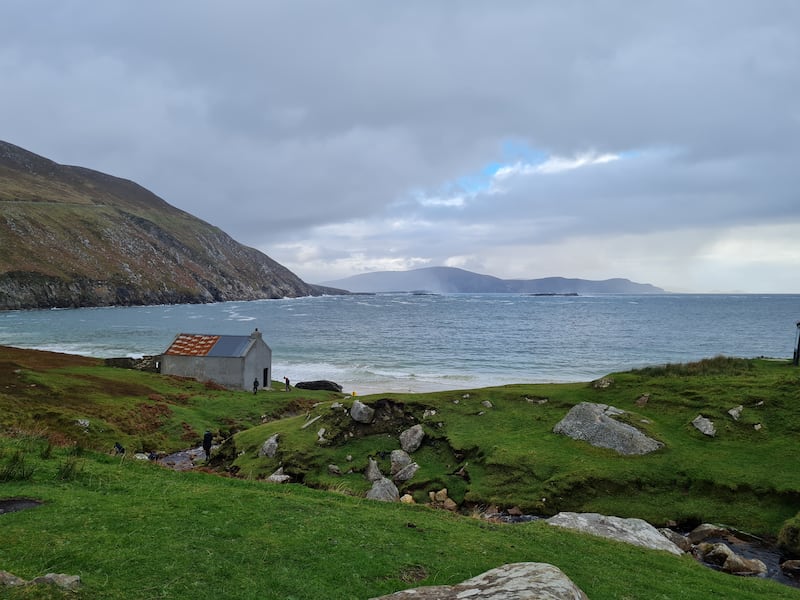This time two years ago, when Banshees in Inisherin were still only a rumour, a correspondent from Achill was already concerned about the effects of mass tourism on the island.
His immediate concern then was the proposed “Keem Bay Discovery Point”: a sort-of glass walkway and sculpture to be built on the cliff there. A local TD predicted it would be a “must-see” for tourists. Having seen the plans, my man in Achill declared it “hideous”.
But his general point was that, even before the installation of a discovery point, Keem Bay was already being discovered a rate with which it couldn’t cope.
Illegal campers overwhelmed the water supply, which had run out the previous summer. They also filled the only car park, at the end of a narrow twisting descent, so that in high seasons, gardaí had to close the road.
War and diplomacy – John Mulqueen on how Anglo-Irish relations deteriorated during the Falklands conflict
Music to our ears – Paul Clements on 150 years of the Belfast Philharmonic Society
Shades of Gray — Brian Maye on pioneering idealist Sir John Gray
No expenses spared – Alison Healy on a journalistic tradition
Thanks to the film, Keem Bay is now also known as the location of Colm Doherty’s house (and by extension of his sheepdog, who missed out in the Oscar nominations despite delivering the movie’s best joke with deadpan comic timing).

After objections from locals, the Discovery Point plan appears to be in abeyance: my correspondent tells me the project “is lying low but not dead”.
The now world-famous banshees loom, meanwhile, with dreadful portent. He fears for the summer.
***
In a restaurant in California last autumn, I was confronted by a bottle of Cabernet Sauvignon made by a local winery named “Banshee”.
This was before the film came out. It was also months before Ireland mooted plans to put health warnings on alcohol bottles, although in associating wine with a wraith-like spirit who foretells imminent death, the Californians seemed to have had similar ideas.
Naturally, I assumed there was a colourful explanation for the name. But if there was, the winery’s website doesn’t have it. Even under “our story”, there is nothing about Ireland or the supernatural. The nearest thing to a curse was in the mission statement: “Banshee strives to produce some of the best damn pinot noir in Sonoma County.”
Not having our cultural baggage, of course, Americans are less inclined to worry about the implications of such names. Back in the 1960s, notoriously, the Pontiac car company made a series of high-speed sports models called Banshee.
The head of the company then was John DeLorean, later infamous for the futuristic cars he tried to make in Northern Ireland. Perhaps it was their doom that the wailing Pontiacs foretold.
Back in California, they have a history of mixing alcohol with the supernatural. The Eagles mixed them doubly. “So I called up the captain, please bring me my wine,” they sang. “We haven’t had that spirit here since 1969,” came the reply, displaying a very loose grasp of viticulture and distilling.
***
Banshees had largely disappeared in Ireland by 1969, or even earlier. Along with other ghosts, they seem to have been eradicated by the rural electrification in the 1950s, and perhaps the decline in poitín consumption.
But the Banshees of Inisherin also remind me of a story Benedict Kiely once told in this newspaper. It came to him from the US, from a friend in Indiana, although she remembered it from her youth in Omagh, where she had a neighbour named, for the purposes of the tale, Joan.
“Joan was unabashedly fond of the boys, was cool and calculating about them,” recalled the exile in Indiana. “She was attractive in a hard sort of a way, with jade-green eyes. Lacking any imagination at all, she yet told me a story one time that shook me.”
Joan was working at the time in Derry, in an ice cream parlour, but hadn’t written home for a while.
“Her mother was worried and, on learning that I was to visit Derry, asked me to contact Joan. I found the place where she worked, along the Strand [and] gave her the message. With her usual cool, she shrugged her shoulders and said: “Tell her I’ll be home tomorrow for my grandmother’s funeral.’
“Startled, I said: ‘Your grandmother isn’t dead. I saw her this morning, alive and well’. Joan simply shrugged again. Next day she was home. Her grandmother was dead and Joan was at the funeral.”
There had been no banshees involved. Those were aristocratic spirits, after all, foretelling deaths only in certain families of Gaelic noble lineage. Joan’s grandmother had appeared in person to her the day before. Like the old women in the film, she was “in her usual attire, black dress and black shawl”.
No words were spoken, but they had always been close and the granddaughter knew what it meant. “She was always so matter-of-fact about everything,” wrote her friend in Indiana. “That was the only time in all the years I knew her that she evidenced any belief in the supernatural.”

















